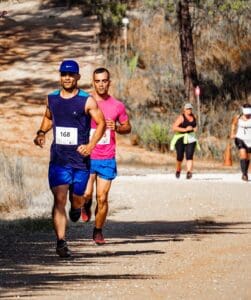Bone stress injuries are commonly related to overuse among runners and up to two thirds of long distance and competitive cross-country runners will experience this problem. The most common areas affected are the shin, lower leg, heel and foot bones.

In a normal situation, the bone responds to the load from weight bearing exercise by making itself stronger which is why exercise like walking and running are recommended for good bone health. If there is enough recovery time between runs then the bone copes well with this process and adapts to get stronger.
The development of bone stress injuries occurs over a continuum when the repetitive strain put on the bone due to running, gradually exceeds the bone’s capacity to strengthen itself. If this process is repetitive and/or exceeds the bone’s capacity to a load and hasn’t had enough time to recover then this may lead to a stress reaction which is the beginning of a bone stress injury. This is typically when the bone starts to cause pain. If this cycle continues then a stress fracture may develop and in the later stage may lead to a complete bone fracture.
The main issues that need to be considered are things that change how much load is placed on the bone and the bone’s capacity to tolerate load.
When assessing a runner, we look at the following things to determine whether they are contributing to the problem (or putting you at risk of bone stress injury):
An understanding of load and a runner’s capacity is crucial for the management of bone stress injuries.
When load is greater than capacity there is an increased risk of the onset and progression of bone stress injury!
When capacity is greater than load the risk and severity of bone stress injury reduces!
Typically bone stress injuries present with a history of gradual worsening of symptoms over a period of time. It is also important to note that symptoms can occur very quickly in the area of bone stress.
Signs and symptoms can vary and depend on what stage along the continuum of injury. Initially pain may be described as vague and a mild ache that occurs during a specific period of running which settles after ceasing the activity. Bone stress injuries usually worsen as you continue to run, and the pain does not settle as you ‘warm up’ unlike tendon pain (another common running problem).
As the injury progresses the runner may experience more severe and localised pain which may persist after the completion of an activity and during lower bone loading activities such as walking. Towards the later stage runners may experience pain at rest and night, and potential redness, swelling and warmth over the affected area in the presence of an underlying inflammatory component. A runner’s participation in their normal activities may become quite restricted and/or discontinue.
During clinical assessment range of motion and strength testing may not be able to pick up bone stress injuries. Symptoms may be provoked by specific bone loading tests such as walking, running, jumping, hopping etc. Localised tenderness over bone may be noted during palpation. If a stress fracture is suspected clinically, MRI imaging is recommended to assess the severity of the injury and potential presence of a fracture line which can be further evaluated by CT scan.
 Bone stress injuries don’t respond well with continued running with pain, and continuing to run despite the pain will typically make the problem worse in the long term.
Bone stress injuries don’t respond well with continued running with pain, and continuing to run despite the pain will typically make the problem worse in the long term.
A period of modified weight-bearing and rest will be required prior to a gradual return to running. This will be guided by your treating physiotherapist. During this period, it will be important to maintain your physical conditioning of other unaffected areas such as your upper body if your lower body is affected, and to maintain some cardiovascular fitness such as performing cross training in the form of stationary bike, rowing or swimming.
Your physiotherapist will help you plan a program to maintain your fitness and flexibility while you are modifying your running training. This could include seeing an Exercise Physiologist to ensure the training you do is as safe and effective as possible.
If issues have been identified with your footwear, previous/old orthotics or foot biomechanics, a podiatrist may be consulted to assess these and provide recommendations to assist your return to running safely.
Recovery timeframes can vary between each runner. Severity of bone stress injury, location of injury, nutritional and hormone status and the general bone mineral density have been shown to be key factors to influence return to running timeframes, in addition to the risk factors listed earlier in this blog.
Your physiotherapist will work with you to assist your return to walking or a graded return to running once the initial period of modified weight-bearing is completed. The training plan needs to be tailored to the individual and monitored closely to ensure that the problem is not recurring.
Some key suggestions for endurance-based runners include:
If you’d like to see Sam Campagnale or one of our other Physiotherapists for this issue, you can:
Dietitian Role Description Move for Better Health is seeking a new dietetics provider for our clinics. We...Read More
At Move for Better Health, one of our key goals is to help you move more. We...Read More
At Move for Better Health, we understand that optimising your health over the life span can be...Read More

